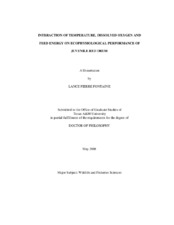| dc.contributor.advisor | Neill, William H. | |
| dc.creator | Fontaine, Lance Pierre | |
| dc.date.accessioned | 2008-10-10T20:58:45Z | |
| dc.date.available | 2008-10-10T20:58:45Z | |
| dc.date.created | 2008-05 | |
| dc.date.issued | 2008-10-10 | |
| dc.identifier.uri | https://hdl.handle.net/1969.1/85983 | |
| dc.description.abstract | The red drum (Sciaenops ocellatus) is important for recreational fishing and
aquacultural production in Texas' coastal waters and elsewhere in the nearshore Gulf of
Mexico and in subtemperate to subtropical areas of the western North Atlantic Ocean. I
performed indoor-tank and outdoor-pond experiments, in conjunction with automa ted
respirometry and ecophysiological modeling, to assess interacting effects of temperature,
dissolved-oxygen concentration (DO) and feed energy density on survival, growth,
metabolism, and other measures of juvenile red drum performance.
The main objective was to test an energy/metabolism tradeoff hypothesis, which
states that growth of fish exposed to high temperatures can be limited by available feed
energy; whereas, growth of fish exposed to lower temperatures can be limited by their
metabolic capacity to exploit available feed energy. Also, I examined the influence of
DO on this relationship and evaluated the effects of cyclical regimes of temperature and
DO on fish performance. Insights from laboratory-based feeding trials were
incorporated in experiments conducted in hatchery ponds to assess effects of oxygen supplementation and dietary additives - nucleotides and prebiotics - on performance in
a more natural setting.
In examining these issues, various technologies were developed. These included
a computer-based apparatus for autonomously inducing cyclical regimes of temperature
and DO in experimental tanks over an extended period of time. Additionally, I
developed a soft feed with low energy-density to simulate natural forage.
Experimental results supported the principal research hypothesis: At high
temperature and DO, ecophysiological performance of juvenile red drum was enhanced
by feeding to satiation with a high-energy feed (15.9 kJ/g) versus with a foragesimulating
feed having lower energy density (4.1 kJ/g). Cyclical regimes of temperature
and DO - as imposed in my particular laboratory experiments -did not impart growth
benefits; however, the potential for enhanced growth via an appropriate cyclical
environmental regime remains intact. Results from outdoor-pond experiments were
consistent with laboratory results; however, the strong positive effect of feed energy
density overwhelmed potential effects of dietary additives or oxygen supplementation on
growth. | en |
| dc.format.medium | electronic | en |
| dc.language.iso | en_US | |
| dc.publisher | Texas A&M University | |
| dc.subject | red drum | en |
| dc.subject | environment | en |
| dc.title | Interaction of temperature, dissolved oxygen and feed energy on ecophysiological performance of juvenile red drum | en |
| dc.type | Book | en |
| dc.type | Thesis | en |
| thesis.degree.department | Wildlife and Fisheries Sciences | en |
| thesis.degree.discipline | Wildlife and Fisheries Sciences | en |
| thesis.degree.grantor | Texas A&M University | en |
| thesis.degree.name | Doctor of Philosophy | en |
| thesis.degree.level | Doctoral | en |
| dc.contributor.committeeMember | Vega, Robert R. | |
| dc.contributor.committeeMember | Gatlin, Delbert M. | |
| dc.contributor.committeeMember | Speed, Michael | |
| dc.contributor.committeeMember | Grant, William E. | |
| dc.type.genre | Electronic Dissertation | en |
| dc.type.material | text | en |
| dc.format.digitalOrigin | born digital | en |


